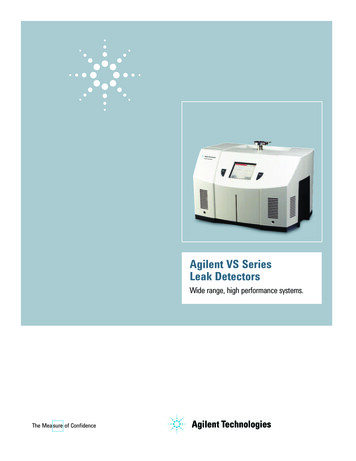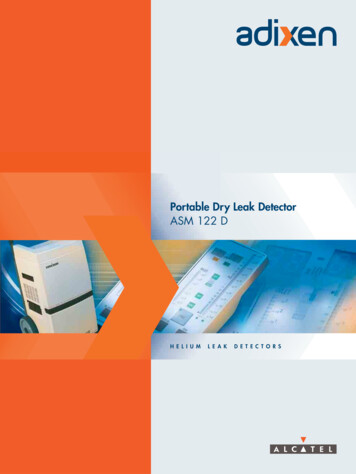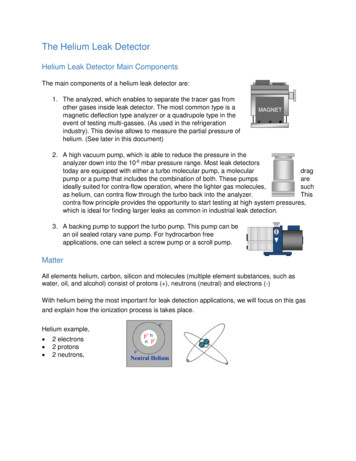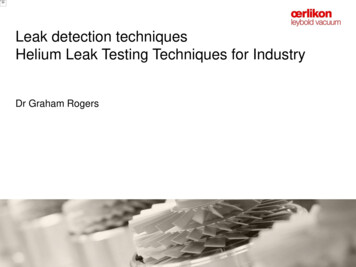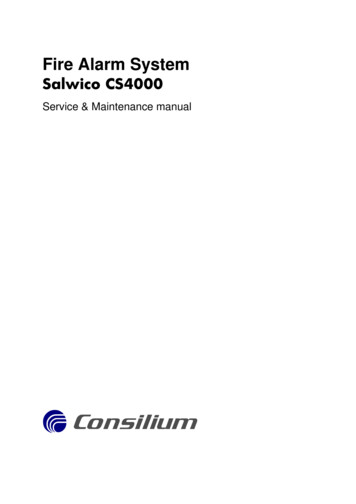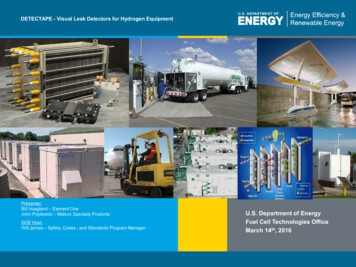
Transcription
DETECTAPE - Visual Leak Detectors for Hydrogen EquipmentPresenter:Bill Hoagland – Element OneJohn Poplawski – Midsun Specialty ProductsDOE Host:Will James – Safety, Codes , and Standards Program Manager1 Fuel Cell Technologies OfficeU.S. Department of EnergyFuel Cell Technologies OfficeMarch 14th, 2016eere.energy.gov
Question and Answer Please type your questions into thequestion box22 Fuel Cell Technologies Officeeere.energy.gov
Safety, Codes and Standards OverviewFuel Cell Technologies Office 3Emphasis R&D Activities: H2 Behavior, RiskAssessment/Mitigation,Materials Compatibility, H2 FuelQuality, Metering, Sensors,Component Testing Safety Management &Resources: Hydrogen SafetyPanel, Databases, and TrainingProps Outreach: Codes & Standardsand Permitting, ContinuousCodes and StandardsImprovement, ResourceDisseminationEnable the widespread commercialization of hydrogen and fuel cell technologies through the timely development ofcodes and standards and dissemination of safety information
NREL Sensor Testing LaboratoryFuel Cell Technologies Office 4 Provide independent assessment of hydrogensensor performance Interact with manufacturers to improve sensorperformance to meet DOE 2012 targets Support deployment with information and expertiseon sensor use and performance Test/validate new sensor R&D Support hydrogen sensor codes and standardsdevelopment (national and international) Outreach and Education Publications, presentations, consultations Student Internships Client confidentialityThe ultimate goal of the Hydrogen Sensor Testing Laboratory is to ensure that end-users get the sensing technology theyneed
Visual Leak Detectors for Hydrogen EquipmentPresented by
PRESENTERSBill Hoagland Element OneJohn Poplawski MSP20 Years in Hydrogen Research12 Years in Silicone Manufacturing
WEBINAR SUMMARY Company BackgroundsLeak Detection SummaryBenefits of Low-Cost Visual Leak DetectorsDetecTape H2 Technology and PerformanceApplications and MarketsAvailability and Upcoming Developments
ELEMENT ONE BACKGROUND Incorporated in 2005 and began R&D of products based on corepatent (U.S. Patent #6,895,805). Key members are veterans of NREL. Collaboration with NREL2005 - present. Conduct thin film research in NREL’s Hydrogen Sensor Laboratory. Funded contracts with DOE/NREL, NASA, Industry. Licensingagreements with industry. One technology license with NREL. Four patents, three pending. In 2015, partnered with MSP to create and market DetecTape .www.elem1.com
DOE RecognitionMarch 2013NREL: 2012 Industrial Growth Forum Presenting Company2014 NREL Commercialization Assistance Program2016 Small Business Voucher AwardMarch 2012August 2014
DETECOAT AND DETECTAPE Thin films and “Smart” coatings forthe detection of leaked or leakinghydrogen to achieve a new level ofreliability and make possible a widearray of very low cost gas detectionproducts.
APPLICATIONS Tapes and wraps Leak detecting pipe covers Safety badges and warning signs Leak detection coatings Pressure/reaction vessels andstorage containers Sensors
HYDROGEN CHARACTERISTICS Odorless and colorless High propensity to leak Low ignition energy Invisible flame High energy content Lighter than air - diffuses rapidlyDifficult to Detect Leaks
IMPORTANCE OF GAS LEAK DETECTION Gas detection is a critical element of the safemanufacture, handling and use of many industrial gases. The 700 million gas detection market, served by morethan twenty-five OEMs and hundreds of maintenancecontractors, is mature and stable with a projected annualgrowth in the 3 to 6% range. The global hydrogen market in 2015 was estimated at53 million metric tons with 12% in the merchant hydrogenmarket with a growth rate of 5-6% per year.
CURRENT LEAK DETECTION METHODS Bubble Testing – Simple spottest method with no continuousmonitoring at low pressures.Thermal Conductivity – Workswell in stable environments withminimal temperature change,background gas must haveconductivity very different fromhydrogen.Catalytic Combustion –Detects heat of combustion,works well for lowconcentrations. Not for purehydrogen.Electrochemical – Sensors usea liquid electrolyte, but varyingtemperature affects gas diffusionmaking the sensor unreliable. Mass Spectrometers –Extremely sensitive, expensive,require skilled operators andmay have long response times.Gas Chromatographs – Similarto mass spectrometers and havethe same disadvantages.Ultrasonic – Technologyimproving, but cannot determineexact location or whethercombustible mixture is present.Semi-Conducting Oxide –Sensor relies on surface effectswith a minimum oxygenconcentration. Performancedegrades at lower temperatures.
THE IDEAL LEAK DETECTOR Very Low-cost – affordably used prolifically at potential leak sites; Positive Indication of both the presence and the absence of hydrogen; Simple, reliable, easily incorporated into the system, no power source; Hydrogen specific and sensitive; Quick response, but no false indications; Durable, long useful life requiring little or no maintenance; and Detectable by one or more of the human senses (sight, smell, sound).
TECHNICAL APPROACHESTo meet varying requirements, Element One’s research hastaken two directions:1. Thin films that both change color and resistance for use in lowcost wireless sensors; and2. Color changing pigments for coatings for visual indication.Vacuum depositedmulti-layer thin filmSynthesizednano-particles
PIGMENTS VS. THIN igmentsThin FilmsSlowerFasterVacuum depositionprocessBoth visual andVisual onlyresistance changeIncorporated intoMulti-layer thin-filmcarriersdevicesMore pigment per unit Less pigment per unitareaareaExtremely durable,Less durable, requiresresistant toselectively permeablecontamination,protective coating.sunlight (UV), acids,bases, moisture.Thick coatings, paints, Resistive/wireless H2inks, wraps, moldedsensors, detection ofEasier to produce
Chemo-chromic chemical reactions: result of a partialreduction of a transition metal oxidea partial oxidation of a catalyzed transitionmetal oxide pigment of 20% effects a readilyvisible color change from light gray to virtuallyblack.
CHEMO-CHROMIC RESPONSETransition Metal Oxide Powder (no encapsulant)
RESPONSE VS. TEMPERATURE Respondsmore quicklyat highertemperatures.
THRESHOLD of SENSITIVITY Thin filmindicationthreshold inair is lessthan 400ppm H2
RESPONSE VS. CONCENTRATION Speed ofResponse isproportional toHydrogenconcentration.
DETECTAPE H2(patent pending)A chemo-chromic (colorchanging), self-fusingsilicone tape designed todetect hydrogen gas (H2)leaks in storage,transmission and generationfacilities.
DETECTAPE H2 RESPONSE TESTGas: 5.7% H2/N2Pigment 0.004g/in2Calculated H2 Req’d: 0.2 ml H2 /in2
E1 DETECTAPE H2 TESTS Controlled leak at 0.5 ml/sec, 15 psiStart150 ml300 ml1,800 ml5 minutes20 minutes60 minutesPhoto credits: Element One, Inc.
So If a typical wrap of DetecTape H2 is 6 in2;and if it takes only .2 ml to change 1-in2 .Why does it take a leak of 300ml to completelychange color?
Not all leaked gas reacts withthe DetecTape H2 pigment
E1 DETECTAPE EXPOSURE TESTS(60 days and counting) 67º C under water 113º C in air 126º C in air? 195º C in air south-facing outdoors (sun) south-facing outdoors (shade) under NaOH solution pH 10 under HCl solution pH 2When exposed to hydrogen, all samples except the one exposed to 195º /-5º Cturned dark within 2 minutes. A significant darkening was apparent within 1 minute.
NREL TESTING OF DETECTAPE H2 Test duration: 8 months (on-going) 55 applications of DetecTape H2 atNREL H2 compressor and dispensingstation Nine clear and verified leaks wereindicated Four were “out-of-normal” requiringrepair; four were “normal” (e.g., valveweep holes); one was noted forfurther monitoring
NREL TESTING OF DETECTAPE H2The deployment study was initiated with laboratory exposure testing Temperature cycling (-7 C to 44 C) Humidity cycling at ambient temperature (dry to 94% rh) Humidity cycling at elevated temperatures(56% and 75% relative humidity at 43 C) Hydrogen exposures - after the temperature and humidity cycling,the indicator response was verified using 5.7 vol.% H2 in N2.Result: Temperature and humidity cycling did not affect thefunctionality of the indicators.
NREL DEPLOYMENT STUDY
NREL Deployment tests:Clear indication of a leakPhoto credits: K. Hartman/W. Buttner, NREL
NREL TESTING DATAPhoto credits: K. Hartman/W. Buttner, NREL
NREL TESTING DATA This indication was seen asthe initiation of a slightdarkening of the pigment.Since the color change wasnot as obvious as otherindications, this indicator willcontinue to be monitored.Photo credits: K. Hartman/W. Buttner, NREL
Conclusions drawn from databy Element One1. DetecTape H2 was shown to reliably identifyunintended hydrogen releases from complex pneumaticsystems.2. DetecTape H2 was verified as a viable technology toidentify small hydrogen leaks which would otherwise goundetected. The identification of such leaks facilitatesimplementation of appropriate corrective action beforethe potential occurrence of major adverse events.
DETECTAPE H2PRODUCTION AND MARKETINGMSP, Inc.John PoplawskiExecutive VP / COO
MSP BACKGROUND 1997 – Established as “Tommy Tape Manufacturing” 2000 – Acquired by Midsun Group (est. 1992 Southington, CT),a leading provider of animal mitigation and corrosion coatingproducts designed for electric utilities 2006 – Renamed to Midsun Specialty Products, Inc. 2009 – Moved operations to Berlin, CT 40 employees Manufacturer and distributor of self-fusing silicone tapes,corrosion protection, and specialty products worldwidehttp://www.midsunsp.com
CHANGES COLOR UPON DETECTIONUpon hydrogen detection,tape changes color fromlight grey to dark black. Noticeable changewithin 3 minutes. Significant changewithin 30 minutes.
SELF-FUSING SILICONE Cross-linking siliconebonds to itself on contact.Does not use adhesives,leaves no residue on substrate.Naturally resists UV and mostcorrosive chemicals.Protected by a special removableliner before installation.Potential for vibration dampening.Conforms smoothly whenwrapped aroundirregular shapes.
FEATURED IN
TEMPERATURE RANGE Extreme Temperature RangeAs low as 0 F (-17 C)As high as 350 F (176 C)Detection reaction time may bereduced or improveddepending on temperature.** Temperature data still being collected. Subject to change **
HYDROGEN REACTION Silicone is a hydrogen permeable carrier forchemo-chromic pigment that changes color whenexposed to hydrogen.
HYDROGEN SAFETY INTEREST Very large quantities of hydrogen are safely used inindustry today, but it’s hard to contain and difficult to detectleaks. Hydrogen is a very large industrial commodity with agrowing market. The introduction of hydrogen as a consumer fuel hascaused heightened concerns over its safety with acorresponding increased interest in hydrogen sensors.
HYDROGEN REACTION Leak Rate and ConcentrationDetermine Speed of Color Change.*Formula in Development* Cumulative Effect –Slow or small leaks can lead tosignificant color change over a longperiod of time. Reaction is permanent after hydrogenis detected, tape replacement isrecommended after repair.
EASY TO USE Can be easily installed by on-sitemaintenance, inspection teams orequipment operators.No certified training required. Does not require power to operate. Can be used in unison with existingleak detection tools including sniffersand ultrasonic detectors.
INTENDED USAGEDetecTape H2 can be wrapped onmost objects including: Connections, Fittings and Reducers Swagelok and NPT Rigid Pipeline Flexible Tubing Flanges Welded Seams and Joints
INTENDED USAGE Initially wrap DetecTape H2 on all hydrogen connectionsthat may be leak prone or susceptible to vibration damage. Leave DetecTape H2 on connections permanently or untila leak is detected and a repair needs to be made. Can be easily removed with a blade or scissor. Once repair is complete and connection is in working order,wrap with DetecTape H2 to monitor for future leaks.
USAGE LIMITATIONSDetecTape H2 is not intended to: be used to stop nor slow down a leak. be used to detect anything other than hydrogen gas. prevent other gases from mixing with hydrogen.
COUNTRY OF ORIGIN All components of DetecTape H2 aremanufactured in the United States. Tape core denotes Country of Origin. Hydrogen reactive pigment synthesized inBoulder, Colorado USA. Tape manufactured inBerlin, Connecticut USA.
DOCUMENTATION New Product Announcement SheetProduct Data SheetSafety Data SheetInstruction SheetVideos (Coming Soon)NREL Deployment StudyComing Soon
TAPE ROLL SPECThickness – 10 mil (0.01 inch / 0.254mm) thickProfile – Rectangular / 10 mil acrossWidth – 1 inch (25mm) wideLength – 15 feet (4.57m) longColor – No leak detected : Light greyLeak Detected : Cumulative dark black blotches Guideline – Blue to denote Hydrogen Gas Detector Current Perforation – 4 inch (10cm) strips
PERFORATIONStrips perforated to specific lengths depending on object diameter. 1/16” – 1/8” (1mm - 4mm) diameter – 4” strip (10cm)40-45 applications per roll NOW AVAILABLE ¼” – ½” (6mm – 12mm) diameter – 8” strip (20cm)25-30 applications per roll * Coming Soon * 1” – 4” (25mm – 100mm) diameter – 12” strip (30cm)10-12 applications * Coming Soon * Multiple strips can be used onlarge diameters.** Configurations still in trial stages.Subject to change based on user feedback **
CONTAINER DetecTape H2 15 foot rolls areshipped in a re-usable clarifiedpolypropylene container to keeproll clean and dry while not in use. Portable enough to fit a roll inpocket, tool belt or toolbox.
USER INSTRUCTIONS Every roll comes with userinstallation and detectioninstructions. More information anddocumentation (SDS, PDS, FAQ)is available to users onhttp://www.detectape.com
APPLICATIONS Use on connectionsinside cabinets that areinspected on a routineschedule. Quickly identify hydrogenleaks during inspections.
APPLICATIONS Use on hydrogen supplyconnection points in fuelingstations. Attendants and maintenancecrews can react quickly with avisual alert that there is ahydrogen leak present.
APPLICATIONS Use on all hydrogen networkconnections that are withinvisual range of inspectionroutes. Prioritize leak repair basedon quantity of alerts in azone to maximize efficiency.
APPLICATIONS Use on hydrogen-relatedresearch equipment toimprove laboratory safety. Once a leak is detected,equipment operator cansafely shut downequipment for repair.
APPLICATIONS Useful in conjunction withother gas detection alarmsystems. Expedite repairs byvisually identifyinglocalized connections.
OTHER APPLICATIONS On-Site Hydrogen GenerationManufacturing (Semiconductor, Aerospace, Etc.)Power Plants (Using Hydrogen Coolant)Gas Processing and ProductionMetallurgy and WeldingPortable Power UnitsPharmaceuticalAnd More
AVAILABILITY Samples available upon request throughwebsite. Limited trial rolls available at introductoryrate in exchange for user feedback anddata. Case pack – 36 rolls / case Single rolls available with 5 roll MOQ Available for Purchase
UPCOMING DEVELOPMENTS H2 Reversible Tape - Hydrogenreaction is reversible. Designed fortightly enclosed spaces where in-airhydrogen may be a concern over time. H2S Tape – Hydrogen Sulfideleak detection for use as amarker for natural gas pipelineleaks.
ACKNOWLEDGEMENTS We would like to thank the Office of EnergyEfficiency and Renewable Energy’s Fuel CellTechnologies Office for their continued support. We would like to thank Dr. William Buttner andNREL for the cooperation and assistanceprovided to Element One, Inc.
THANK YOU FORWATCHINGQ&ASESSIONhttp://www.detectape.com
Thank YouPresenters: Bill Hoagland - Element One–whoagland@elem1.com John Poplawski – MSP–info@detectape.comDOE Host: Will James – Safety, Codes , and Standards Program Manager–Charles.James@EE.Doe.GovWebinar Recording and Newsletter news-and-financial-opportunityupdates)65 Fuel Cell Technologies Officeeere.energy.gov
FREQUENTLY ASKED QUESTIONS1. What range of hydrogen concentration has the tape been measured /proven with?2. What other components have been included in the testing forQuestion 1?3. What is the repeatability of the tape’s performance, i.e. does thesame size leak produce color at the same rate?4. Is there a correlation of leak amount versus color change rate?5. What is the impact on temperature on the color change?
FREQUENTLY ASKED QUESTIONS6. What is the longest that the tape is been in use for any of the tests?7. How can we tell if the tape is still working after it has been in servicefor a time? (eliminate false negatives)8. Are there any other components that may cause false positives?9. Are there any other components that may interfere with thehydrogen response? (eliminate false negatives)10. Is the tape sample we received the same as will be sold forcommercial use?
IMPORTANCE OF GAS LEAK DETECTION Gas detection is a critical element of the safe manufacture, handling and use of many industrial gases. The 700 million gas detection market, served by more than twenty-five OEMs and hundreds of maintenance contractors, is mature and stable with a projected annual growth in the 3 to 6% range. The
